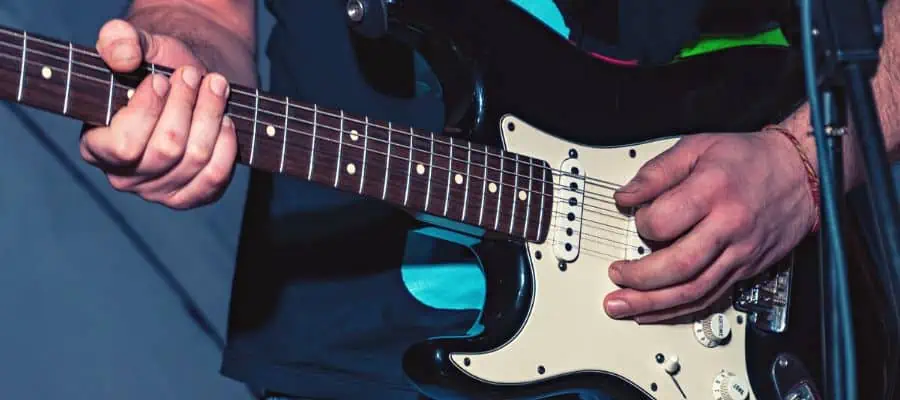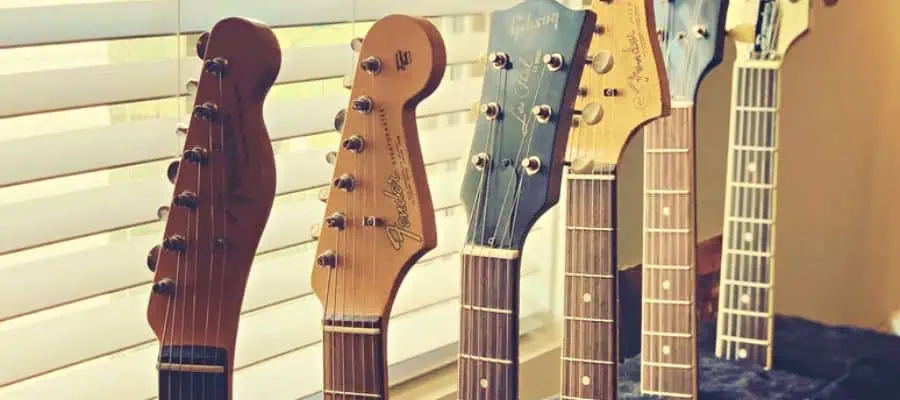As a guitarist, you may have played several different guitars, both acoustic and electric. Besides the most common differences between these two types of instruments, you may have also noticed that electric guitars typically have thinner necks than acoustic ones.
Generally, electric guitars have thinner necks compared to acoustic guitars, because this neck type practically allows for faster playing styles, especially for solos. Moreover, with thinner neck techniques such as bending, and fretting with the thumb, legatos are much easier and smoother to do.
If you want to know more, read the rest of this article. I will explain why most electric guitars have thinner necks than acoustic ones and then list some pros and cons of these types of guitar necks.
Why Thin Necks Work Better for Electric Guitars

While different guitars have varying levels of neck thickness, it’s safe to say that most electric guitars have thinner necks compared to acoustic guitars. This is something you may have observed yourself, but it is also a fact for the majority of instruments on the market. There are a few reasons why this is the case:
Faster Playing
Both thin and thick necks can be practical, but thin necks are especially ideal for electric guitars. The narrower space allows the fingers to move faster across the board, allowing the guitarist to play any tune faster and easier. Thin necks come in handy for lead guitarists who need to play solos, allowing them to play faster and better.
Ease of Techniques
Moreover, a thinner neck makes some techniques like bending, legatos, hammer-ons, and pull-offs smoother and easier. The bending technique, for instance, can be quite challenging on a thick neck, since it requires support with the whole hand.
A thick neck would be much more challenging, especially for a person with smaller hands. For the most part, a thinner neck makes playing an electric guitar much easier. Also, bending multiple strings is much easier on thinner necks, as the strings sit closer to each other.
Another important technique is fretting with the thumb which is almost impossible with thicker necks. With thinner necks, the thumb can reach the lower strings and fret the low E string, creating a more flexible playing experience.
Pros and Cons of Thin Guitar Necks

As mentioned above, both acoustic and electric guitars can have both thin and thick necks, depending on what they’re used for. Thin necks are generally more suitable for electric guitars, but they can be beneficial for acoustic guitars as well. Here are some pros and cons that can help you understand what type of neck thickness you need for your guitar, be it acoustic or electric.
Pros
- Thin necks are better for beginners. Understandably, the thinner the neck, the easier it is for the player to wrap their hand around the neck and play the chords correctly.
- Thin necks are better for solos. As mentioned above, thinner necks are also beneficial for professionals who want to play solos or use fingerstyle rather than a pick. The limited space helps the fingers move more easily.
- Thin necks are better for fast playing. With a thin neck, you can change the positioning of your fingers more easily, which can help you play faster songs.
Cons
- Thin guitar necks are less durable. Understandably, a thinner guitar neck has more chance of warping over time, since it contains less solid material that would provide stability. Moreover, a thinner guitar neck can break more easily. But with maintenance and care, this is far from being an issue.
- Thin necks may affect the tone of the guitar. A thinner neck creates a brighter and less powerful tone compared to thicker necks. Typically, a thin neck creates a thinner and brighter sound but with many effects and amplification, you won’t hear the difference. This is more of a concern for acoustic instruments.
- Some guitarists are not comfortable with thin necks. Depending on what you’re used to, you may not feel comfortable playing with a thinner neck, even though it’s easier to use in theory. Especially players with large hands may find it hard to play with thinner necks.
Can Electric Guitars Have Thick Necks?

While most electric guitars have thin necks for the reasons I explained above, certain electric guitars have thicker necks. These guitars are made for musicians who have larger hands and enjoy more support. For instance, semi-hollow body jazz guitars come with slightly thicker necks.
If you’re looking for an electric guitar with a thick neck, you have plenty of options. Gibson guitars in particular are known for their generally thick necks, especially the Gibson Les Pauls. Gretsch guitars are also known to produce various thick-neck guitars, like the G6120 and G5420. Fenders also offer some thick neck options, like the Telecasters with a U-shaped neck.
Different Guitar Neck Types

- Slim “C” Profile: This is one of the most popular electric guitar neck profiles as it offers a comfortable grip with a gradual curve. It is preferred for balanced, smooth, and fast playing as it provides the sweet spot between playability and thickness. Fender Stratocasters and Gibson Les Pauls often come with “C” type necks.
- Vintage “V” Neck: Known for the distinct “V” shape they offer, these necks are thicker than modern neck profiles. They are preferred for their comfort and feel as they fill the hand better than most other neck profiles. Also, these necks were used to stabilize the neck before the truss rods came into play. Many acoustic and electric guitar brands like Martin use “V” necks for their vintage models.
- Thin and Modern “D” Profile: Many modern electric guitars offer thin “D” profile necks that are built for only and only speed and ease of play. They are the go-to necks for shredders and guitarists, who require precise and quick fretwork. Some modern electric guitar brands like Ibanez as well as guitars with more than 6 strings use this neck profile very often. Also, there are some Gibson guitars like Les Pauls and SGs using a combination of “D” and “C” profile necks.
- Ultra-Thin “Wizard” Necks: Designed for genres like progressive rock and heavy metal, “Wizard” necks are modern recent creations that are ultra-thin and great for shredding and fast playing styles. They can be considered thinner “D” profile necks. Superstrat-style guitars, especially from Ibanez, have “Wizard” necks for ultimate shredding.
- Baseball Bat “U” Necks: These necks are chunky and rounded with high shoulders. As they have thick neck profiles, they are great for large hands and players who like to have their thumbs on the back of the neck. Baseball Bat necks are often found on the Telecasters and T-style guitars.
Final Thoughts
Electric guitars typically have thinner necks than acoustic ones for a few reasons. First of all, thinner necks are more practical, because they allow the player to play all sorts of chords more easily and move faster on the fretboard. It’s a better solution for solid-body guitars that don’t need more volume.
Acoustic guitars need thicker necks to amplify the sound more and to support the hollow body. However, certain electric guitars have thicker necks. These guitars are suitable for guitarists with large hands and those who prefer a certain sound.
If you found this article useful, you may want to save this pin below to your Guitar board.

Recent Posts
When learning new songs have you noticed that some of the chord sequences sound really good? But when you tried to come up with your own chord sequence, or as we call it chord progression, you found...
Some guitarists insist on buying an expensive amplifier with their electric guitar. They assume that this is a must for every type of guitarist out there. However, in some situations, this isn’t...

